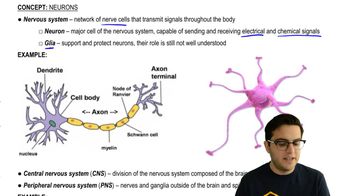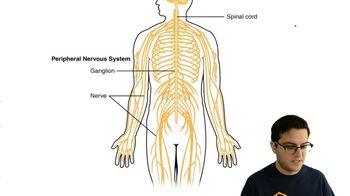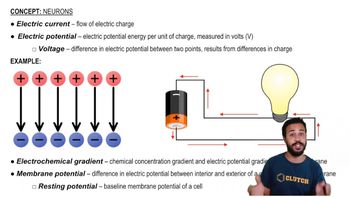Table of contents
- 1. Introduction to Biology2h 42m
- 2. Chemistry3h 40m
- 3. Water1h 26m
- 4. Biomolecules2h 23m
- 5. Cell Components2h 26m
- 6. The Membrane2h 31m
- 7. Energy and Metabolism2h 0m
- 8. Respiration2h 40m
- 9. Photosynthesis2h 49m
- 10. Cell Signaling59m
- 11. Cell Division2h 47m
- 12. Meiosis2h 0m
- 13. Mendelian Genetics4h 44m
- Introduction to Mendel's Experiments7m
- Genotype vs. Phenotype17m
- Punnett Squares13m
- Mendel's Experiments26m
- Mendel's Laws18m
- Monohybrid Crosses19m
- Test Crosses14m
- Dihybrid Crosses20m
- Punnett Square Probability26m
- Incomplete Dominance vs. Codominance20m
- Epistasis7m
- Non-Mendelian Genetics12m
- Pedigrees6m
- Autosomal Inheritance21m
- Sex-Linked Inheritance43m
- X-Inactivation9m
- 14. DNA Synthesis2h 27m
- 15. Gene Expression3h 20m
- 16. Regulation of Expression3h 31m
- Introduction to Regulation of Gene Expression13m
- Prokaryotic Gene Regulation via Operons27m
- The Lac Operon21m
- Glucose's Impact on Lac Operon25m
- The Trp Operon20m
- Review of the Lac Operon & Trp Operon11m
- Introduction to Eukaryotic Gene Regulation9m
- Eukaryotic Chromatin Modifications16m
- Eukaryotic Transcriptional Control22m
- Eukaryotic Post-Transcriptional Regulation28m
- Eukaryotic Post-Translational Regulation13m
- 17. Viruses37m
- 18. Biotechnology2h 58m
- 19. Genomics17m
- 20. Development1h 5m
- 21. Evolution3h 1m
- 22. Evolution of Populations3h 52m
- 23. Speciation1h 37m
- 24. History of Life on Earth2h 6m
- 25. Phylogeny2h 31m
- 26. Prokaryotes4h 59m
- 27. Protists1h 12m
- 28. Plants1h 22m
- 29. Fungi36m
- 30. Overview of Animals34m
- 31. Invertebrates1h 2m
- 32. Vertebrates50m
- 33. Plant Anatomy1h 3m
- 34. Vascular Plant Transport1h 2m
- 35. Soil37m
- 36. Plant Reproduction47m
- 37. Plant Sensation and Response1h 9m
- 38. Animal Form and Function1h 19m
- 39. Digestive System1h 10m
- 40. Circulatory System1h 57m
- 41. Immune System1h 12m
- 42. Osmoregulation and Excretion50m
- 43. Endocrine System1h 4m
- 44. Animal Reproduction1h 2m
- 45. Nervous System1h 55m
- 46. Sensory Systems46m
- 47. Muscle Systems23m
- 48. Ecology3h 11m
- Introduction to Ecology20m
- Biogeography14m
- Earth's Climate Patterns50m
- Introduction to Terrestrial Biomes10m
- Terrestrial Biomes: Near Equator13m
- Terrestrial Biomes: Temperate Regions10m
- Terrestrial Biomes: Northern Regions15m
- Introduction to Aquatic Biomes27m
- Freshwater Aquatic Biomes14m
- Marine Aquatic Biomes13m
- 49. Animal Behavior28m
- 50. Population Ecology3h 41m
- Introduction to Population Ecology28m
- Population Sampling Methods23m
- Life History12m
- Population Demography17m
- Factors Limiting Population Growth14m
- Introduction to Population Growth Models22m
- Linear Population Growth6m
- Exponential Population Growth29m
- Logistic Population Growth32m
- r/K Selection10m
- The Human Population22m
- 51. Community Ecology2h 46m
- Introduction to Community Ecology2m
- Introduction to Community Interactions9m
- Community Interactions: Competition (-/-)38m
- Community Interactions: Exploitation (+/-)23m
- Community Interactions: Mutualism (+/+) & Commensalism (+/0)9m
- Community Structure35m
- Community Dynamics26m
- Geographic Impact on Communities21m
- 52. Ecosystems2h 36m
- 53. Conservation Biology24m
45. Nervous System
Neurons and Action Potentials
Problem 4`
Textbook Question
Why are action potentials usually conducted in one direction?
a. Ions can flow along the axon in only one direction
b. The brief refractory period prevents the reopening of voltage-gated Na⁺ channels
c. The axon hillock has a higher membrane potential than the terminals of the axon
d. Voltage-gated channels for both Na⁺ and K⁺ open in only one direction.
 Verified step by step guidance
Verified step by step guidance1
Understand the concept of action potentials: Action potentials are rapid electrical signals that travel along the axon of a neuron, allowing communication between neurons.
Learn about the refractory period: After an action potential occurs, there is a brief period during which the neuron is unable to fire another action potential. This is known as the refractory period.
Explore the role of voltage-gated Na+ channels: During the refractory period, the voltage-gated Na+ channels are temporarily inactivated, preventing the initiation of another action potential in the same region.
Consider the directionality of action potential conduction: Due to the refractory period, the action potential cannot travel backward because the Na+ channels behind the action potential are inactivated, ensuring one-way conduction.
Evaluate the options: Option b is correct because the brief refractory period prevents reopening of voltage-gated Na+ channels, ensuring that action potentials are conducted in one direction.
 Verified video answer for a similar problem:
Verified video answer for a similar problem:This video solution was recommended by our tutors as helpful for the problem above
Video duration:
56sPlay a video:
Was this helpful?
Key Concepts
Here are the essential concepts you must grasp in order to answer the question correctly.
Action Potential
An action potential is a rapid rise and subsequent fall in voltage or membrane potential across a cellular membrane, primarily in neurons. It is initiated when a neuron sends information down an axon, away from the cell body, and involves the opening and closing of ion channels, particularly sodium (Na+) and potassium (K+) channels.
Recommended video:
Guided course
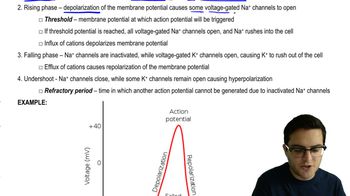
Action Potential
Refractory Period
The refractory period is a short time after an action potential during which a neuron is unable to fire another action potential. This period is divided into the absolute refractory period, where no new action potential can be initiated, and the relative refractory period, where a stronger-than-normal stimulus is required. It ensures unidirectional propagation of the action potential along the axon.
Recommended video:
Guided course

Action Potential
Voltage-Gated Ion Channels
Voltage-gated ion channels are proteins in the cell membrane that open or close in response to changes in membrane potential. These channels are crucial for the generation and propagation of action potentials, as they allow the selective flow of ions like Na+ and K+, which alters the membrane potential and facilitates the transmission of electrical signals along neurons.
Recommended video:
Guided course
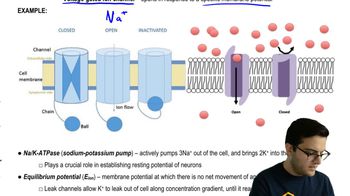
Ion Channels and Pumps
Related Videos
Related Practice



